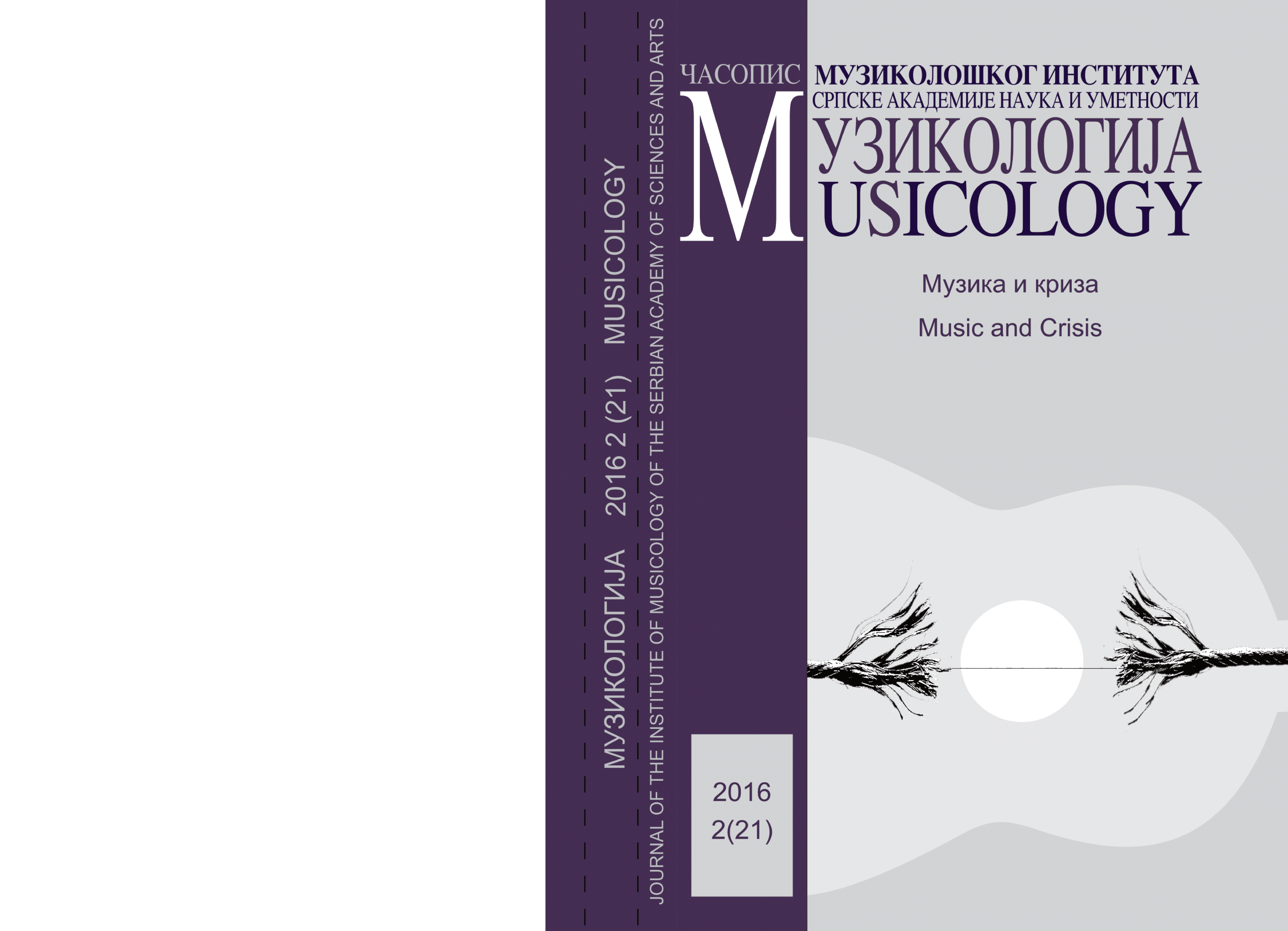The Fate of the Postmodern World: on Melancholy and Rebellion by Milan Mihajlović
Усуд постмодерног света: о Меланхолији и Револту Милана Михајловића
Keywords:
Милан Михајловић, меланхолија, цитатност, концепт круга, постмодернаAbstract
The musical оеuvre of Milan Mihajlović (b. 1945) enjoys a high reputation and position in contemporary Serbian music. This has been proven by the many awards he has received, countless performances of his compositions at home and abroad, and especially by the warm and approving reactions of the audience. The stylistic consistency in his oeuvre is a result of his creative use of Scriabin’s scale. The concept of this scale was first theoretically elaborated in an extensive study written by Mihajlović in 1980 and, since then the scale has been functioning as a crucial cohesive element in all Mihajlović’s compositions. The novelty in his oeuvre, composed during the 1990s, were intertextual references made by using citations from his own works and those of other composers (Monteverdi, Mozart, Stravinsky, Rachmaninov, Vasilije Mokranjac). The most characteristic features of his mature style are also recognizable in his recent works Melancholy (2014) and Rebellion (2015). The interval structure of Skriabin’s scale is projected along the horizontal (melodical) and vertical (harmonical) axes of the both works while the formal design resulted from shifts of tensions and relaxations. Developmental sections are based on variation and improvisation of the small number of different motifs (three basic ones in Melancholy, four in Rebellion) above the metrically moveable ostinato layers and the releases are marked by change of tempo, dynamic, meter and texture. The most significant and radical release is the one which marks the abrupt ending of Rebellion by the physical gesture of slamming down the keyboard lid. As the composition was written for the BUNT festival (Belgrade) it fits the festival’s idea of expressing resistance to the government’s neglect of academic musicians and institutions. In the wider sense, it becomes a sign of the resistance to the world we live in, and that is the world of lost ideals. Both works are composed for the wind instrument and the piano quartet and in the both cases the author’s voice, with its figures of sorrow and anger, is personified in singing, narrative lines of the wind instrument (the oboe in Melancholy and French horn in Rebellion respectively). These two compositions also demonstrate the specific concept of a circle that is intuitively searched for and ingeniously implemented. It is manifested by the cyclic concept of Scriabin’s scale and projected in all of the author’s compositional procedures as a vehicle for the expression of lament and resignation.
References
Agawu, K. (1991) Playing with signs, Princeton, New Jersey: Princeton University Press.
Alpers, P. (1996) What is Pastoral?, London: The University of Chicago Press.
Feld, A. (2011) Melancholy and The Otherness of God; a Study of Hermeneutics of Depression, Lanham: Lexington Books.
Freud, S. (1937) “Mourning and Melancholy”, in J. Strachey (ed.) The Standard Edition of Complete Works of Sigmund Freud, Vol. 14, London: The Hogarth Press, 243–258.
Hatten, R. (2003) Interpeting Musical Gestures, Topics and Tropes; Mozart, Beethoven, Schubert, Bloomington and Indianopolis: Indiana University Press
Jameson, F. (1995) Postmodernizam u kasnom kapitalizmu, Beograd: Art Press [Postmodernism, or the Cultural Logic of Late Capitalism].
Krasnohorkaj, L. (2013) Melanholija otpora, Beograd: Plato [The Melancholy of Resistance, Belgrade: Plato].
Mihajlović, M. (1980) „Skrjabinov modus”, Zvuk 2: 30–49 [“Scriabin’s Mode”, Sound 2: 30–49.]
Мијатовић, Б. (1994/95) „Кристали сећања: Мементо Милана Михајловића”, Нови Звук 4–5: 123–132 /Mijatović, B. (1994/5/95) „Kristali sećanja: Memento Milana Mihajlovića”, Novi Zvuk 4–5: 123–132 [“Crystals of Memory: Memento by Milan Mihajlović”, New Sound 4–5: 123–132].
Panofsky, E. (2005) The Life and Art of Albrecht Dürer, New Jersey: Princeton University Press.
Premate, Z., Stefanović, I. i Hofman, S. (1984) „NOTTURNI za solo hornu, duvački i gudački kvartet Milana Mihajlovića”, Treći program Radio Beograda 4: 28–37 [“NOTTURNI for solo horn, wind and string quartet by Milan Mihajlović”, Radio Belgrade Third Programme 4: 28–37].
Schoenberg, A. (1978) Theory of harmony, translated by Roy Carter, Berkeley and Los Angeles: University of California Press. Scruton, R. (1983) The Aesthetic Understanding, London: Methuen.
Starobinski, Ž. (2011) Melanholija u ogledalu – tri čitanja Bodlera, prevod Bojan Savić Ostojić, Loznica: Karpos [Melancholy in a Mirror – three readings of Bodler, translated by Bojan Savić Ostojić, Loznica: Karpos].
Stefanija, L. (1996) „Allen Forte: vprašanja ob analitični metodi teorije nizov/množic”, in J. Weiss (ed.) Muzikološki zbornik 32/1, Ljubljana: Ljubljana University Press, Faculty of Arts, 107–120 [“Allen Forte: Questions Regarding the Analytic Method of Set Theory”, in J. Weiss (ed.) Musicological Annual 32/1, Ljubljana: Ljubljana University Press, Faculty of Arts, 107–120].
Šuvaković, M. (1997) Postmoderna (73 pojma), Beograd: Narodna knjiga [Postmodernism (73 notions), Belgrade: National Books].
Веселиновић-Хофман, М. (2007) „Постмодерна – карактеристике и одабири ’игре’”, у Н. Кнежевић-Жуборски и Т. Поповић-Новаковић (ур.) Историја српске музике, Београд: Завод за уџбенике, 247–292 /Veselinović-Hofman, M. (2007) „Postmoderna – karakteristike i odabiri ’igre’”, u N. Knežević-Žuborski i T. Popović-Novaković (ur.) Istorija srpske muzike, Beograd: Zavod za udžbenike, 247–292 [“Postmodern music – characteristics and selection of ‘play’”, in N. Knežević-Žuborski and T. Popović-Novaković (eds.) History of Serbian Music, Belgrade: Institute for textbooks, 247–292].
Downloads
Published
Issue
Section
License
Copyright (c) 2016 MUZIKOLOGIJA-MUSICOLOGY

This work is licensed under a Creative Commons Attribution-NonCommercial-NoDerivatives 3.0 Unported License.
You are free to:
- Share — copy and redistribute the material in any medium or format.
The licensor cannot revoke these freedoms as long as you follow the license terms.
Under the following terms:
-
Ауторство — You must give appropriate credit, provide a link to the license, and indicate if changes were made.
You may do so in any reasonable manner, but not in any way that suggests the licensor endorses you or your use. -
Некомерцијално — You may not use the material for commercial purposes.
-
NoDerivatives — If you remix, transform, or build upon the material, you may not distribute the modified material.
- No additional restrictions — You may not apply legal terms or technological measures that legally restrict others from doing anything the license permits.



